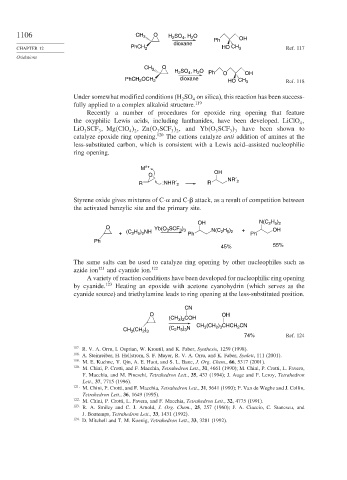Page 1130 - Advanced Organic Chemistry Part B - Reactions & Synthesis
P. 1130
1106 CH 3 O H SO , H O OH
2
2
4
dioxane Ph
CHAPTER 12 PhCH 2 HO CH 3 Ref. 117
Oxidations
O
CH 3
H SO , H O Ph O OH
2
2
4
PhCH OCH 2 dioxane HO CH 3 Ref. 118
2
Under somewhat modified conditions (H SO on silica), this reaction has been success-
2 4
fully applied to a complex alkaloid structure. 119
Recently a number of procedures for epoxide ring opening that feature
the oxyphilic Lewis acids, including lanthanides, have been developed. LiClO
4
LiO SCF Mg ClO Zn O SCF , and Yb O SCF have been shown to
3
3
3
4 2
3 3
3
3 2
catalyze epoxide ring opening. 120 The cations catalyze anti addition of amines at the
less-substituted carbon, which is consistent with a Lewis acid–assisted nucleophilic
ring opening.
M n+
O OH NR′
R :NHR′ 2 R 2
Styrene oxide gives mixtures of C- and C-
attack, as a result of competition between
the activated benzylic site and the primary site.
H )
OH N(C 2 5 2
O Yb(O SCF ) N(C H ) + OH
3 3
3
+ (C H ) NH Ph 2 5 2 Ph
2 5 2
Ph
45% 55%
The same salts can be used to catalyze ring opening by other nucleophiles such as
azide ion 121 and cyanide ion. 122
A variety of reaction conditions have been developed for nucleophilic ring opening
by cyanide. 123 Heating an epoxide with acetone cyanohydrin (which serves as the
cyanide source) and triethylamine leads to ring opening at the less-substituted position.
CN
O OH
(CH ) COH
3 2
(CH ) CHCH CN
CH 3
CH (CH ) (C H ) N 2 3 2
2 5 3
3
2 3
74% Ref. 124
117
R. V. A. Orru, I. Osprian, W. Kroutil, and K. Faber, Synthesis, 1259 (1998).
118 A. Steinreiber, H. Hellstrom, S. F. Mayer, R. V. A. Orru, and K. Faber, Synlett, 111 (2001).
119
M. E. Kuehne, Y. Qin, A. E. Huot, and S. L. Bane, J. Org. Chem., 66, 5317 (2001).
120
M. Chini, P. Crotti, and F. Macchia, Tetrahedron Lett., 31, 4661 (1990); M. Chini, P. Crotti, L. Favero,
F. Macchia, and M. Pineschi, Tetrahedron Lett., 35, 433 (1994); J. Auge and F. Leroy, Tetrahedron
Lett., 37, 7715 (1996).
121 M. Chini, P. Crotti, and F. Macchia, Tetrahedron Lett., 31, 5641 (1990); P. Van de Weghe and J. Collin,
Tetrahedron Lett., 36, 1649 (1995).
122
M. Chini, P. Crotti, L. Favera, and F. Macchia, Tetrahedron Lett., 32, 4775 (1991).
123 R. A. Smiley and C. J. Arnold, J. Org. Chem., 25, 257 (1960); J. A. Ciaccio, C. Stanescu, and
J. Bontemps, Tetrahedron Lett., 33, 1431 (1992).
124
D. Mitchell and T. M. Koenig, Tetrahedron Lett., 33, 3281 (1992).

